Does your lawn have little pound (or dollar) size spots of pale or bleached grass in it?
Then chances are, it’s suffering from a fungal infection called Dollar Spot Disease.
What is Dollar Spot Disease?
Dollar Spot Disease isn’t very prevalent in the UK. That being said, it is becoming more common.
It’s a fungal disease which mainly affects ornamental lawns made up of fescue grasses. Creeping Red Fescue is most prone to an attack and more and more suppliers include it in their grass seed mixtures.
It can also affect bent grasses and Annual Meadow Grass.
This is why it’s becoming more common.
What Does Dollar Spot Look Like?
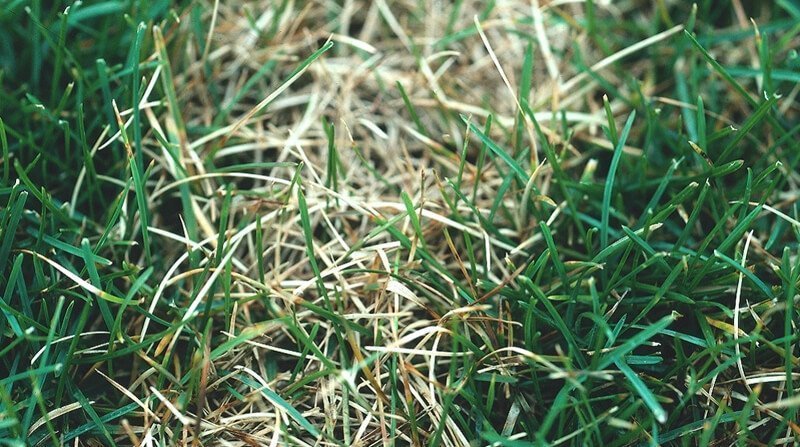
It appears as small spots of pale or bleached grass, usually an inch or two in diameter. You’ll see light tan coloured lesions or infection marks on the grass leaves which have reddish brown edges.
These spots often sink slightly which causes the surface of your lawn to be uneven.
On dewy mornings you might see a cobweb-like mould, similar to that of Snow Mould. Then, when the grass dries, the mould tends to become less visible.
What Causes it to Develop?
Dollar Spot is caused by a fungus called Sclerotinia homeocarpa, which lives in most turfs.
During the Winter it lies dormant in the soil and thatch layer. Then when conditions are right, the fungal spores become active which encourages the disease to develop.
Dollar Spot occurs in periods of hot days with high humidity followed by cool nights. Usually in the Summer and Autumn.
Any situation that causes your lawn to stay damp for long periods of time will contribute to the development of Dollar Spot Disease.
These include;
- Areas of shade
- Low air circulation
- Excess lawn thatch
- Soil Compaction
Low Nitrogen levels in the lawn and cutting the grass too short during hot weather will often stress the grass which can increase the chances and the severity of an attack.
How to Treat Your Lawn For Dollar Spot Disease
Depending on the severity of the attack, there are a couple of ways you can treat your lawn for Dollar Spot.
Do it Yourself
If you catch it early you might be able to get on top of it with a fungicide that amateur or home gardeners can use.
It’s called Bayer Garden Lawn Disease Control and although it’s primarily made to tackle Fusarium Patch and Red Thread, it can work on other fungal infections.
Especially when caught early.
Just mix it with water as per the instructions and apply it with a watering can or knapsack sprayer.
- Can be used at any time of year
- Can be used on a range of fungal lawn infections
Hire a Lawn Care Expert
If your lawn has a major infection then chances are, fungicides that are made for home use won’t work.
In which case I’d advise you call your local lawn care expert.
He/she will have the knowledge and be licensed to use professional fungicides required to deal with such an attack.
How to Prevent Dollar Spot Disease From Occurring (or -Re-Occurring)
Treating your lawn for Dollar Spot Disease is useless if you don’t fix the conditions that caused it to develop in the first place.
To prevent it from infecting your lawn, good lawn care practice is the way to do it.
The following treatments will help greatly:
Reduce Shade and Improve Airflow Around Your Garden
Like many lawn diseases, Dollar Spot occurs in damp conditions.
Reducing the amount of shade and improving airflow will have a big impact.
If buildings cast a lot of shade then chances are you’ll be limited in what you can do.
However, you can improve conditions by;
- Prune trees and remove low hanging branches – trim back trees and try to make sure the lowest branches are at least 3 feet off the ground.
- Prune thick bushes – this will allow light and air to pass through them much more easily.
- Replace fence panels – granted, this is on the more extreme end but replacing solid fence panels with slotted fencing will greatly improve things.
Mow Your Lawn at the Correct Height

Cutting the grass too short in the heat of Summer causes stress, making the lawn more susceptible to disease and infections.
Keep mowing in the Summer but raise the cutting height. This means the grass can store more water and nutrients in its leaves, keeping it healthy.
Remove Dew From the Lawn in the Mornings
Damp conditions cause fungal spores to develop so it’s a good idea to do what you can to remove surface moisture caused by dew.
You can do this by knocking the moisture off the grass, either by switching or dragging a hosepipe across the lawn.
This will give the drying a process a quick start.
Scarify Your Lawn to Reduce Thatch
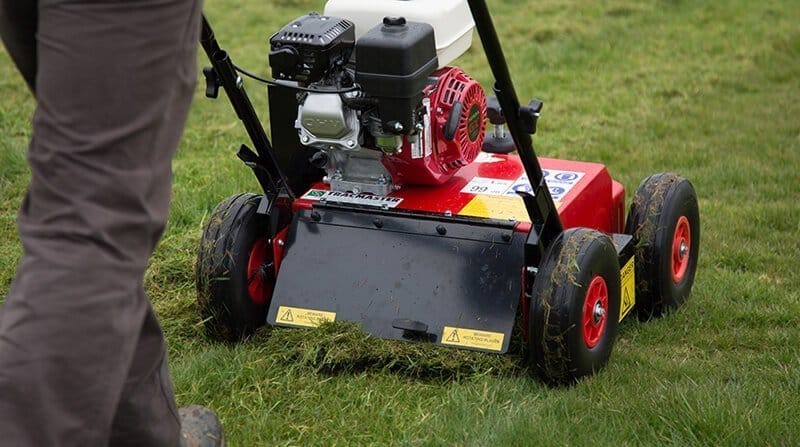
Scarifying to remove excess thatch will do two things;
- It’ll remove the area in which the fungal spores incubate and spore, and
- Improve drainage and help moisture to penetrate the soil where it can be consumed by the grass’ roots
Wait until the Autumn before scarifying as doing it in the Summer will cause even more stress to your lawn.
Read: Best Scarfiers and Lawn Rakes
Aerate Your Lawn to Reduce Soil Compaction
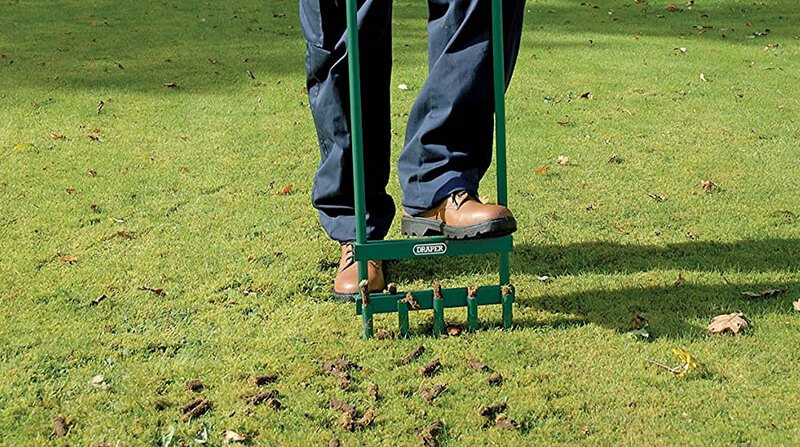
Compacted soil causes moisture to sit on the surface of your lawn as it will be too hard to penetrate.
Spiking your lawn will improve drainage by creating tiny holes that allow water, are and nutrients into the soil.
Hollow tining removes cores of turf which creates spaces for compacted soil particles to relax into. This not only improves drainage and the penetration of air and nutrients, but it also softens the ground enough so the grass’ roots can develop and grow deeper.
Like scarifying, aerate your lawn in the Autumn.
Overseed Your Lawn With Shade Tolerant Grass Seed
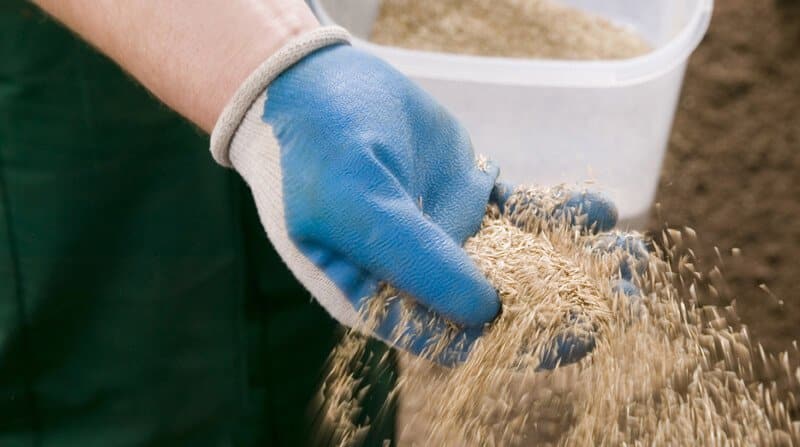
Scarifying and aerating your lawn are invasive treatments which your lawn will need to recover from.
To help aid quick recovery, overseed your lawn with new grass seed.
If your lawn resides in shade, it’s vitally important to use a grass seed blend that is shade tolerant. If you use the wrong type of grass seed, you’ll likely see Dollar Spot develop again.
So use a grass seed mix that is designed for shady areas.
See my article, Best Grass Seed for my recommendations on the best grass seed for shaded lawns.
Fertilise Your Lawn in Spring and Autumn
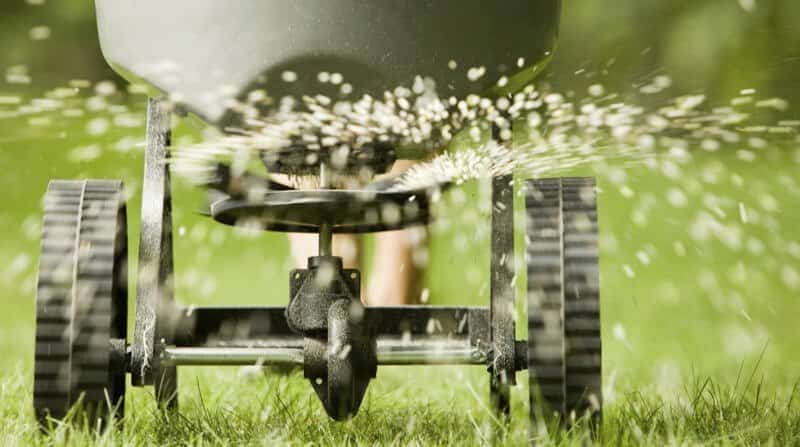
Dollar Spot Disease attacks lawns that are deficient in Nitrogen.
By fertilising your lawn in the Spring with a slow-release lawn feed, you’ll give your lawn the Nitrogen and other nutrients it needs to grow, stay healthy and fight off disease through the Summer.
Again, feeding your lawn again in the Autumn with an Autumn feed will provide it with the nutrients it needs to stay healthy during the damper weather.
Read: Best Lawn Feeds and How to Use Them
In Conclusion
Dollar Spot Disease isn’t very common in the UK but more and more occurrences are popping up.
You can treat and manage it if you catch it early but for more server infections, you might need to hire a lawn care professional.
Over to You
Have you had experience of Dollar Spot on your lawn or is your lawn currently suffering?
I’d love to hear about your experiences so leave a comment below.
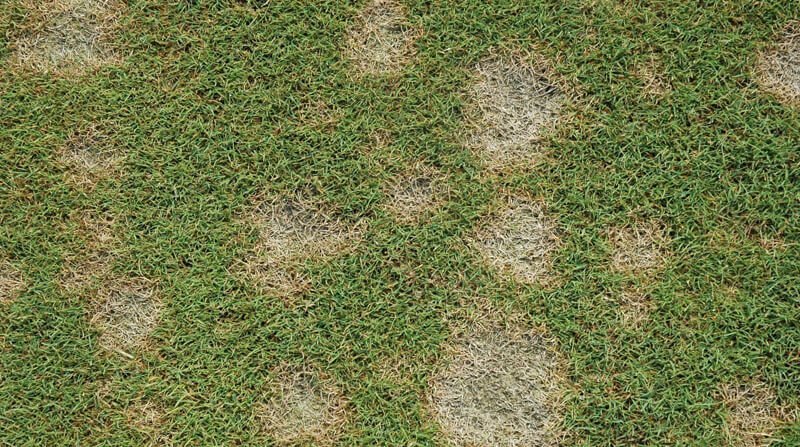


Both the front yard and back were newly reseeded with new loam and seed, the lawn was beautiful. also irrigation system installed. with a scheduled fertilization maintenance program from Tru Green. I noticed mushrooms then pink cloud. and then that was it silver dollar both front and back, ruined. will the yard recover and the end of the summer I will have it thatched and reseeded. how to prevent from happening again. thanks David from Rhode Island